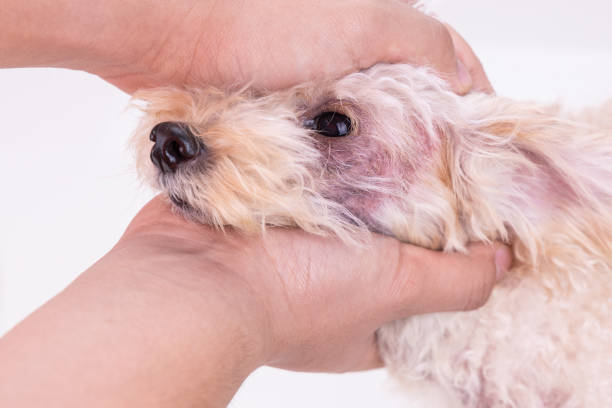Signs of mastitis in canines are similar to those experienced by humans, frequently characterized by swollen and tender breasts. Additionally, a foul odor often originates from the infected area. Generally, the primary factor suspected to cause mastitis in dogs is an infection in the mammary gland, possibly triggered by bacteria, fungi, or protozoa.
It’s important to note that mastitis may not produce any symptoms. Unfortunately, this means that many cases are misdiagnosed until they become complicated or chronic, necessitating surgery to correct the problem if it’s caused by mastitis.
If your dog’s symptoms point more to a mammary tumour or breast cancer, this article may help you learn more about the condition and its symptoms without making this blog entry any longer than it already is.
Signs and Symptoms of Mastitis in Dogs
Different signs can determine whether or not your dog has contracted mastitis. First, you will notice swelling of one or more of your pet’s mammary glands along with a painless inflammation. The next step will be to observe a bright red colour in the affected area and a purulent secretion with a very unpleasant smell.
It’s also common for these symptoms to appear suddenly. Still, they can be caused or exacerbated by external factors such as excessive or rough dog grooming procedures (when performed without proper knowledge), tight clothing (which may irritate the area), and even poor air circulation in certain areas of the body.
Mastitis in dogs may cause swelling of the mammary glands, a painless inflammation, and a purulent secretion with an unpleasant smell.
The causes that lead to mastitis are varied, and they can be found in both small-sized dogs and big ones. Bacterial infections are common in small breeds, but fungal infections are more common in big dogs.
Regardless of the cause or the size of your pet, it is always advisable to seek veterinary assistance as soon as possible so that they can diagnose and treat it as soon as possible.
What to Watch Out For
Your dog can’t tell you they have a problem because of their limited verbal skills. However, there are certain things that you should pay attention to when it comes to your pet’s health. It is essential for you, as a pet owner, to be aware of the symptoms of mastitis in dogs so that you can detect them as soon as possible and get your pet treated.
The symptom that you will definitely notice is swollen mammary glands. These are two vital glands because they produce milk for puppies during lactation. As a result, these glands are especially prone to infection, especially if your dog has given birth within the last three months.
Other mastitis symptoms in dogs are pain, redness, and fever. These aren’t always present when your pet has contracted mastitis, but it’s important to have them in mind because they may be visible signs of a more complicated problem. You shouldn’t ignore them. Therefore, you should always be on the lookout for these symptoms so that your vet can provide you with an accurate diagnosis.
A swollen mammary gland accompanied by redness and pain is a sign of mastitis in dogs.


How often can a dog get mastitis without it becoming chronic/complicated?
As many as three times before it becomes a chronic condition. This is because, sometimes, if a dog has contracted the infection once and the symptoms go away after proper treatment, it will return several months later. This happens because an infection of this kind doesn’t necessarily get rid of all the bacteria that caused it in the first place, which means that it can still come back at any time.
Mastitis Treatment in Dogs
Treatment for mastitis will depend on your pet’s condition, but, most importantly, it will be based on the cause that led to this infection. Likely, your dog won’t have to stay at the clinic for more than a day. However, they may remain on antibiotics for two weeks or more, depending on the severity of their condition. Your dog may also get analgesic medication to relieve pain and reduce fever. You can learn more about how dogs get mastitis here.
When it comes to treating mastitis in dogs, you will have to see your vet so that they can determine which method of treatment is best for your pet.
Does mastitis affect dogs of any age?
Dogs of all ages are susceptible to mastitis, but it is more common in large breeds. Mastitis can cause serious problems for puppies who have just begun to nurse, so the best thing you can do if you own a dog that has recently had babies is to pay close attention to any sign of infection in their mammary glands.
Mastitis can severely affect lactating female pets or nursing babies in the household. Be sure to contact your vet for proper treatment when you notice any swelling, redness, or pain during this time frame.
How do you know when to take your dog to the vet?
This is a prevalent question and one that isn’t always easy to answer. While we know how important it is for pet owners to pay attention to their pets’ health, sometimes they don’t realize that their dog has mastitis until it is too late.
If your dog shows any of the symptoms mentioned above, you should call your vet immediately (or take them there if their condition is very severe). They will make an accurate diagnosis and provide treatment that will help with the swelling, pain, fever, etc. It is only by taking action in time that you can ensure your pet’s comfort at the same time as their good prognosis.


What are the causes of mastitis in dogs?
There are many causes of mastitis in dogs, and they can affect both nursing dogs and those who gave birth. Some of the most common causes of mastitis in dogs are:
- Milk stasis (which means that milk isn’t flowing through the mammary glands).
- A mammary gland infection due to bacteria.
- Dogs with false pregnancies can get mastitis since they produce the same hormones as pregnant dogs. -A blocked milk duct (this can lead to an abscess or a breast tumour).
- Huge dog breeds are more likely to get mastitis, especially if they have had a litter. This is because the mammary glands produce milk for the puppies and become swollen as a result. The main issue with this type of mastitis isn’t the infection itself but the pressure on the area when the mammary gland swells.
- Mastitis can also occur in male dogs, but this is very rare.
What you feed your dog greatly affects their health, and it can lead to mastitis in some cases. For example, if a dog eats many fatty foods or junk food that aren’t suitable for them, this can cause inflammation in their mammary glands, leading to mastitis.


How does a dog contract mastitis?
There are several ways a dog may contract this illness; it can be as simple as licking a sore on their own body, or they could have been near an animal with the condition who passed it onto them through contact with bodily fluids. It’s also possible for an infection to spread from one area of their body – such as their nose – into another otherwise healthy tissue such as a mammary gland.
Sometimes, a dog will develop mastitis because of a health issue unrelated to its reproductive system. Finally, there are also cases where mastitis occurs due to a traumatic injury or surgery. It is considered an iatrogenic condition in these situations, which means it was caused by the treatment (surgery, medication, etc.) rather than an underlying condition.


How is mastitis diagnosed in dogs?
Mastitis can be diagnosed with x-rays to see if there are any abnormalities in the breast tissue. Your veterinarian will also conduct a physical examination of your dog to determine whether or not they have a fever and if their mammary glands are swollen. If it is likely that your dog has mastitis due to the swelling in their mammary gland area, they will also feel for any lumps or masses.
In addition to these tests, they may also conduct a culture on the fluid around your dog’s mammary glands to determine what kind of bacteria or infection is present. If it is suspected that a false pregnancy may have caused the mastitis, they will also conduct tests to determine whether hormone levels are elevated in your dog’s blood, which would confirm this type of condition.


What are the dangers of mastitis in dogs?
You should be concerned about mastitis in dogs because if an infection is present, it can be more dangerous than the inflammation of the mammary gland. It’s important to remember that every case of mastitis is unique, so there are no hard and fast rules regarding how severe your dog’s symptoms are or what their prognosis will look like.
Can you prevent mastitis?
This is another question that isn’t easy to answer because each case is unique and affected by different conditions. However, it’s important to know that there are ways to prevent mastitis from occurring in the first place, such as:
- Not allowing your dog to lick their bodies when they have an open wound.
- Avoid contact with other animals who may be carrying the infection.
- Keep your dog away from places with a high risk of catching certain infectious illnesses.
- Keeping your dog’s immune system healthy.
Conclusion
Mastitis is a common condition in dogs that several different things can cause. If you suspect your dog has mastitis, it’s important to seek veterinary care as soon as possible because the longer this goes untreated, the more difficult it becomes to treat.
Mastitis symptoms include swelling of the mammary glands and pain when touched or handled; if left untreated for too long, mastitis can lead to other health complications such as infection or cancerous growths, which are much harder to manage without treatment. To prevent this from happening, ensure your pet doesn’t lick open wounds on their body (or any wound) and avoid contact with animals who may have contracted this illness.


